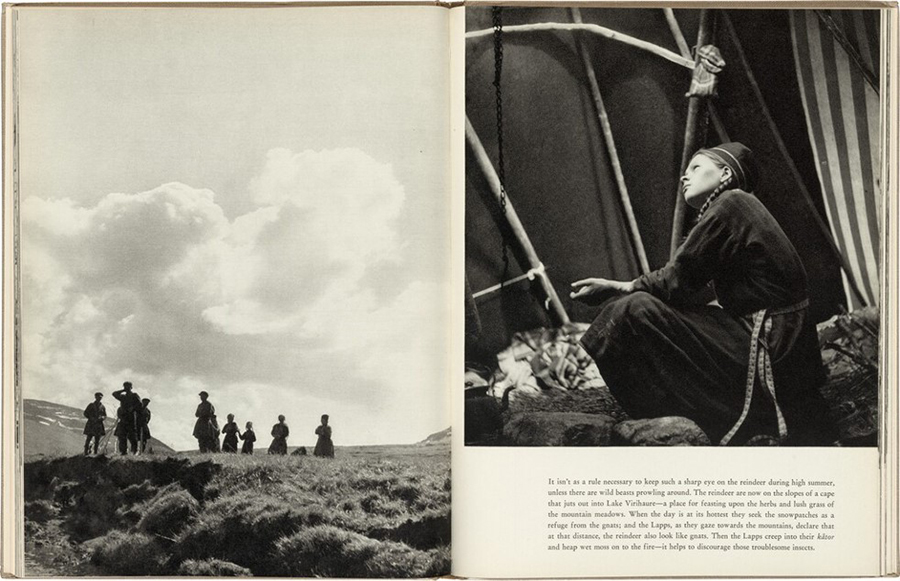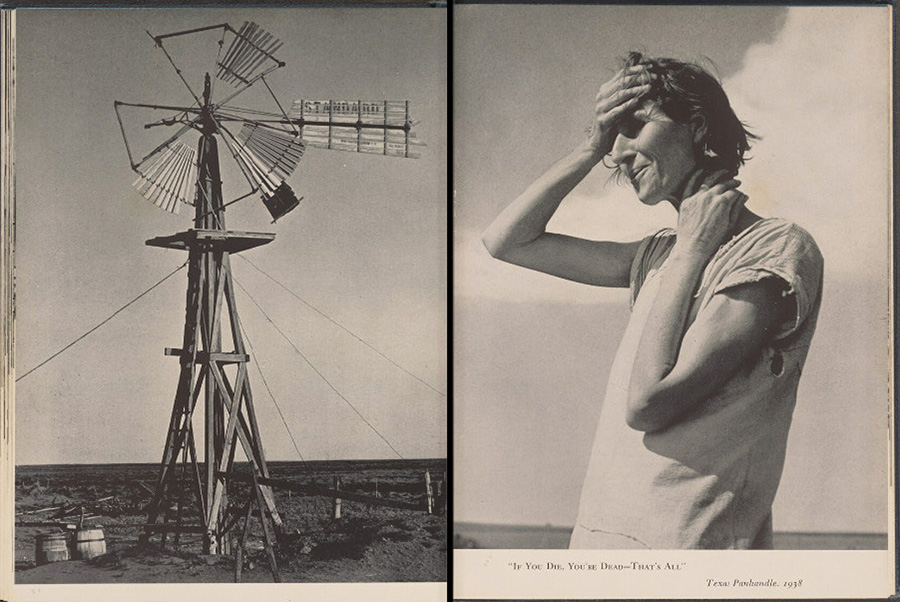Andrea Nelson
Reading Modern Photobooks

Anna Riwkin and Elly Jannes, page spread from Nomads of the North (New York, 1950)
Beginning in the 1920s, well before the advent of the internet and social media, mass-produced photobooks were a new form of visual communication that informed a broad public. Photobooks are publications characterized by the careful sequencing and editing of photographic images to convey visual arguments. Many include photographs along with text and their intermedial construction challenges traditional ways of reading and seeing. Today, photobooks remain a dominant form of presenting and circulating photographic images. They are also an immensely vital mode of expression for contemporary photographers, yet their production and significance has only been the subject of sustained critical analysis within the last two decades. As the history of photography is being reinterpreted through publications like photobooks and magazines, more work needs to be done to understand the cultural and social implications driving the development of these works, including the diverse range of practitioners involved and subjects covered.
My time as an Ailsa Mellon Bruce National Gallery of Art Sabbatical Fellow allowed for the research and writing of a book proposal stemming from my 2007 doctoral dissertation, “Reading Photobooks: Narrative Montage and the Construction of Modern Visual Literacy.” The book project, “Reading Modern Photobooks,” examines how photobooks published from the 1920s to the 1950s both visually constructed history and attempted to model a new way of reading the social and political environment. Through select case studies, I argue that photobooks are central to understanding photography’s role in shaping period discourses on race, gender, nationhood, and cultural difference.

Dorothea Lange and Paul Schuster Taylor, page spread from An American Exodus: A Record of Human Erosion (New York, 1939)
The 1920s were the start of a golden age of photobooks. Improved rotogravure technologies were spurring the reproduction of all kinds of photographic images, and the photobook disseminated them in a format that merged the democratic, mass-cultural photograph with the privileged literary genre of the book. By bringing high and low cultural forms together, such publications promised new access to the modern world, and they were popular across the political spectrum as both documentary record and fine art object. As modernizing societies quickly became dependent upon visual information for their conception of identity, photobooks were understood as a new means of communicating contemporary experience, of visualizing recent events “captured” by the camera. However, as constructed narratives, photobooks were working for a variety of agents and institutions, including photographers, writers, editors, publishers, and governments, and the nature of the histories told between their covers is open to question. I contend an analogical organization of photographic images and texts is at work as the underlying structure of photobooks. I use the term narrative montage to analyze how the associative principles of montage work with the temporal movement of narrative to redefine narrative structure and visualize the intertextuality of the photograph. Defined by the intertwining of motion and stasis, narrative montage focuses on the gaps between juxtaposed photographic and graphic elements, emphasizing both the temporal and spatial construction of the series. These literal spaces are both explicit components of the overall design and implicit gaps of time and information that require the viewer to interact with the work by constructing meaningful transitions and connections.
During my fellowship, I was able to review recent scholarship, which helped to reconceptualize the project for contemporary audiences. As so many scholarly publications have framed photobook construction within geographic and national frameworks, I worked to clarify a transnational position for my project. I was also able to draft an outline for a new chapter that focuses on gender and photobook production. Building upon research for my 2021–2022 exhibition The New Woman Behind the Camera, this chapter seeks to expand the discourse by examining photobooks by women photographers that have contributed to new forms of visual narrative.
My book project aims to reveal the underlying social, political, and aesthetic ramifications of this new construction of visual literacy. It will contribute to discussions regarding the role of the photographic in the development of history and new media constellations—because how we understand the current moment is always impacted by history. Today, we do not question the powerful role of the visual in the production of knowledge; our technological, image-saturated culture is one of multiplicity, of interactive arrangements and analogical sequences. So, while we may be struck by prophetic theories regarding visual literacy promoted during the 1920s, we are less aware of how the photobook became the preferred format for many photographers who were interested in the power and readability of the photograph. With their analogical construction, photobooks engaged in the debate over how history itself can be constructed and understood.
National Gallery of Art, Department of Photographs
Ailsa Mellon Bruce National Gallery of Art Sabbatical Fellow, 2023–2024
Andrea Nelson is associate curator in the department of photographs at the National Gallery of Art. She plans to submit the book proposal written during her sabbatical period to prospective publishers.
